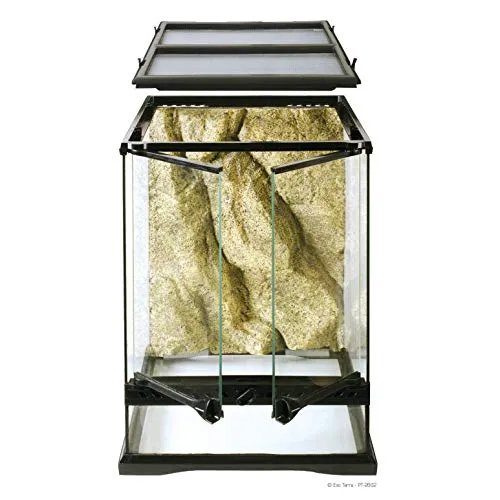What Makes a Great Tarantula Enclosure
Creating the perfect habitat for your tarantula is crucial for its health and well-being. A suitable enclosure provides the necessary environment for your spider to thrive, mimicking its natural habitat as closely as possible. It’s not just about containing your pet; it’s about creating a space where it can feel safe, secure, and comfortable. This means considering a variety of factors from size and ventilation to substrate and decor. A well-chosen enclosure helps regulate temperature and humidity, which are vital for molting and overall health. Furthermore, it should be easy to clean and maintain, ensuring that the enclosure remains hygienic and free from harmful bacteria or fungi. Selecting the right enclosure requires careful consideration of the tarantula species, its size, and its specific needs. This guide will help you navigate the choices and create an enriching environment for your eight-legged friend.
Size Matters Choosing the Right Dimensions
The size of your tarantula enclosure is one of the most important factors to consider. An enclosure that is too small can restrict movement and lead to stress, while one that is too large can make it difficult for the tarantula to find food and feel secure. The general rule is to provide an enclosure that is at least twice the tarantula’s leg span in width and length. However, the specific dimensions will depend on the tarantula’s species, as some species are more terrestrial (ground-dwelling) while others are arboreal (tree-dwelling). Providing adequate space allows your tarantula to move freely, hunt, and engage in natural behaviors. Avoid overcrowding, as this can lead to increased aggression and competition for resources. Also, consider the growth potential of your tarantula; plan for an enclosure that will accommodate its adult size.
Considering Tarantula Species and Size

Different tarantula species have varying needs. Terrestrial species, such as the Chilean Rose Hair or the Giant White Knee, generally require more floor space than height. Arboreal species, like the Pinktoe Tarantula, will benefit from a taller enclosure that allows them to climb and establish their web at a higher level. The size of the tarantula at the time of enclosure selection is also very important. A spiderling, a juvenile tarantula, will require a smaller enclosure compared to an adult. Starting with a smaller enclosure for a young tarantula and upgrading as it grows is often the best approach. This prevents the spiderling from feeling overwhelmed and struggling to find food. Research your specific tarantula species to understand its requirements.
Why Height is Crucial for Terrestrial Tarantulas
While terrestrial tarantulas need ample floor space, height is still important for them. It allows for an appropriate substrate depth, which is critical for burrowing species and those that prefer to hide. A deeper substrate also helps maintain humidity levels. Height also provides a degree of safety, allowing the tarantula to feel less exposed and more secure. Furthermore, providing some height within the enclosure encourages natural behaviors, such as the spider creating a silk retreat or setting up a foraging area. However, avoid excessively high enclosures for terrestrial species, as a fall from a significant height could injure the tarantula. A moderate height allows for the best balance between safety and naturalistic behavior. The substrate and decor should be arranged in a way that minimizes any risk of injury.
Ventilation Importance for Enclosure
Proper ventilation is an absolutely critical aspect of a healthy tarantula enclosure, promoting air circulation and preventing the buildup of harmful mold, bacteria, and excessive humidity. Stagnant air can lead to respiratory problems and can create an unhealthy environment. Good ventilation ensures that the enclosure maintains a stable environment by reducing the likelihood of fungal growth and diseases that can harm the tarantula. Different species of tarantulas have varying ventilation needs. Some species thrive in humid environments, while others prefer drier conditions. The enclosure design, including the number and placement of ventilation holes or mesh, plays a critical role in managing humidity levels and preventing air stagnation. Without proper ventilation, your tarantula’s habitat can quickly become a breeding ground for harmful pathogens and a source of stress for your pet.
Types of Ventilation Systems and Placement

Ventilation systems range from simple drilled holes to more sophisticated designs with mesh or screened tops and sides. The best ventilation setup allows for good airflow without compromising humidity levels. The placement of ventilation is equally important. Holes or mesh should be located on both the top and sides of the enclosure to promote cross-ventilation. This allows fresh air to enter and stale air to exit. Avoid placing all ventilation holes on the top of the enclosure, as this can lead to excessive humidity loss. For humid-loving species, slightly less ventilation may be needed compared to drier species. The number and size of ventilation holes should be adjusted based on the specific needs of the tarantula and the environmental conditions. Regularly check the ventilation holes or mesh for any blockages, such as substrate or debris, that may be obstructing airflow. Proper ventilation is key to maintaining a healthy environment for your tarantula.
Substrate Selection for Best Environment
The substrate is the foundation of your tarantula’s habitat, providing a comfortable surface for walking, burrowing, and maintaining appropriate humidity levels. Choosing the right substrate is critical for creating a healthy and naturalistic environment. The ideal substrate should be able to hold moisture to maintain humidity, allow for burrowing if the species requires it, and be non-toxic. Many different substrates are available, each with its own advantages and disadvantages. Consider the tarantula species’ natural habitat and preferences when selecting the substrate. A good substrate will also provide a degree of security for the tarantula and will help it feel safe and comfortable. It should be replaced periodically to ensure cleanliness and prevent the growth of harmful microorganisms.
Choosing the Right Substrate for Your Tarantula
Common substrate choices include coconut fiber (coco coir), peat moss, vermiculite, and a mixture of these. Coco coir is a popular choice because of its excellent moisture-retention properties and its natural look. Peat moss is also a good option, but it can be more acidic. Vermiculite is useful for maintaining humidity, particularly in drier environments. The choice often depends on the tarantula’s species and its specific needs. For burrowing species, a substrate that allows for digging, like a mix of coco coir and peat moss, is preferred. Avoid substrates with sharp edges or those that could cause harm to the tarantula. Always ensure that the substrate is clean and free from pesticides or chemicals before introducing it to the enclosure. Consider the aesthetic appeal of the substrate, too, as it contributes to the overall look and feel of the enclosure, making it more enriching for both you and your tarantula.
Substrate Depth and Humidity

The depth of the substrate is closely related to humidity control. For burrowing species, a deeper substrate is essential to allow them to dig and create their burrows. The depth also helps to maintain humidity levels as the substrate retains moisture. Monitor the humidity levels using a hygrometer. For species that require higher humidity, the substrate should be kept slightly moist, but not overly wet. For drier species, the substrate should be allowed to dry out between waterings. The substrate should be deep enough to allow the tarantula to feel secure and to provide a buffer against fluctuations in temperature and humidity. The depth of the substrate should be adjusted based on the specific needs of the species and the overall environmental conditions. Proper substrate depth is a key component of a thriving tarantula enclosure.
Essential Decorating and Furnishing
Decorating and furnishing your tarantula enclosure is not just about aesthetics; it also enriches the tarantula’s environment, providing opportunities for natural behaviors such as hiding, climbing, and hunting. Carefully chosen decor creates a more stimulating and secure environment. Incorporating elements that mimic the tarantula’s natural habitat will make your pet feel more comfortable and less stressed. The key is to provide a variety of features that meet the specific needs of the species, taking into account its size, behavior, and habitat preferences. It is also important to prioritize the safety of your tarantula when selecting decor. Ensure that all items are non-toxic and free from any sharp edges or hazards that could injure your pet. The overall goal is to design a space that offers both visual appeal and functional benefits.
Hiding Places and Their Importance
Hiding places are essential for tarantulas as they provide a sense of security, reducing stress and allowing the tarantula to feel safe. In the wild, tarantulas spend a significant amount of time hidden in burrows or under rocks and leaves. Providing a hide, such as a piece of cork bark, a half log, or a commercially available hide, is crucial for the tarantula’s well-being. The hide should be large enough for the tarantula to retreat into comfortably, but not so large that it feels exposed. Place the hide in a location that offers the tarantula some privacy. When the tarantula feels secure, it will be more likely to exhibit its natural behaviors, such as feeding and exploring the enclosure. Having a hide also allows the tarantula to retreat during molting or when it feels threatened.
Providing Climbing Structures

For arboreal tarantulas, climbing structures are crucial for creating an environment that meets their natural needs. Cork bark, branches, and artificial plants provide climbing surfaces and opportunities for the tarantula to establish its web. Even terrestrial tarantulas can benefit from having some climbing structures, as it provides a more stimulating environment and can help them to feel secure. The climbing structure should be stable and securely placed within the enclosure, so it does not pose any risk to the tarantula. Select branches or decor that are free from sharp edges and that are non-toxic. The climbing structure enhances the enclosure design and promotes natural behaviors like climbing and web-building. A well-designed environment will significantly improve your tarantula’s quality of life.
Water and Feeding Dish Placement
The placement of water and feeding dishes is important for both convenience and safety. The water dish should be shallow enough to prevent drowning but provide adequate access to fresh water. Place the water dish away from the hide and potential food sources to prevent contamination. The feeding dish should be easily accessible for the tarantula. Avoid placing it near ventilation openings, where it might attract unwanted insects. When selecting dishes, prioritize materials that are safe and non-toxic. Ensure that both the water and feeding dishes are cleaned regularly to maintain hygiene and prevent the buildup of bacteria. This will create a cleaner environment and reduce any risk of disease. Providing the right dishes in the correct locations will promote both health and well-being.
Temperature and Humidity Control
Maintaining the correct temperature and humidity levels within the enclosure is critical for your tarantula’s health. Temperature and humidity are essential for various physiological processes, including molting, feeding, and digestion. Different tarantula species have different requirements, so it is important to research the specific needs of your pet. Incorrect temperature or humidity levels can lead to health problems, such as dehydration, respiratory infections, or problems during molting. Regular monitoring and adjustments are essential to keep the enclosure within the ideal range. Creating the right environmental conditions will significantly contribute to the overall health and well-being of your tarantula.
Monitoring Temperature

Use a reliable thermometer to monitor the temperature inside the enclosure. Place the thermometer in a location that provides an accurate reading of the overall temperature. The ideal temperature range will vary depending on the species. It’s essential to maintain consistent temperatures. If you live in a cooler climate, you might need to use a heat source, such as a heat mat placed on the side of the enclosure or a low-wattage incandescent bulb. Avoid placing the heat source directly under the enclosure, as this can cause the substrate to dry out. Never place the heat source directly inside the enclosure where the tarantula can come into contact with it, as this can lead to burns. Regularly check the temperature and make adjustments as needed to ensure the correct conditions.
Maintaining Proper Humidity Levels
Humidity levels can be measured using a hygrometer. The humidity requirements vary based on the species, but most tarantulas thrive in a humidity range of 60-80%. For species that require higher humidity, misting the enclosure with dechlorinated water can help to increase humidity. Ensure that the enclosure has adequate ventilation to prevent mold and fungal growth. The substrate also plays a crucial role in maintaining humidity levels. A substrate that retains moisture, such as coco coir or peat moss, is often recommended for humidity-loving species. Monitor the humidity levels regularly and make adjustments as needed, either by misting the enclosure, adjusting the ventilation, or changing the substrate.
Enclosure Materials and Safety
The materials used to construct the tarantula enclosure are very important for the safety and well-being of your pet. The enclosure should be durable, escape-proof, and easy to clean. It is important to choose materials that are non-toxic and that do not pose any risk to the tarantula. Avoid materials that have sharp edges or that could be easily damaged. The enclosure should provide clear visibility, which is important for observing your tarantula’s behavior and monitoring its health. Regular inspection of the enclosure is very important for ensuring safety. The right material will improve the overall experience for both you and your pet.
Glass vs Acrylic Enclosures

Glass and acrylic are the most common materials used for tarantula enclosures, each with its own advantages and disadvantages. Glass enclosures are durable and scratch-resistant, providing excellent visibility. They can be easier to clean, but they can be heavier and more prone to breakage. Acrylic enclosures are lighter than glass and less prone to shattering, making them a safer choice. They also have excellent insulation properties, which can help to maintain stable temperatures and humidity levels. However, acrylic can scratch more easily than glass and may require special cleaning solutions. The best choice will depend on your specific needs and preferences. Consider the durability, safety, and ease of maintenance when deciding between glass and acrylic.
Features to Avoid
There are certain features to avoid when selecting a tarantula enclosure. Do not use enclosures with sharp edges or those made from toxic materials. Avoid enclosures with large gaps or openings that could allow the tarantula to escape. Do not use enclosures with lids that are not secure. Avoid using materials like untreated wood, which can absorb moisture and harbor bacteria. Also, steer clear of enclosures with poor ventilation, which can lead to excessive humidity and mold growth. Avoid placing the enclosure in direct sunlight, as this can cause overheating. Lastly, avoid enclosures with features that could potentially harm the tarantula. Always prioritize the safety and well-being of your pet when making a selection.
Cleaning and Maintenance
Regular cleaning and maintenance are essential for maintaining a healthy environment and preventing the buildup of harmful bacteria and mold. A clean enclosure will also make it easier to observe your tarantula and identify any potential health problems. Develop a regular cleaning schedule that includes both spot cleaning and full enclosure cleanings. These tasks will maintain a safe and comfortable environment for your pet. Make sure that any cleaning products that you use are non-toxic and safe for use around tarantulas. Regularly assess the condition of the enclosure, and make adjustments as needed to ensure that your tarantula is living in optimal conditions. This will promote both the health and happiness of your pet.
Regular Cleaning Schedule
Establish a consistent cleaning schedule to keep your tarantula’s enclosure in good condition. Spot clean the enclosure regularly, at least a few times a week, to remove any uneaten food, fecal matter, and dead insects. A full enclosure cleaning should be done less frequently, usually every few months, depending on the species and the size of the enclosure. During the full cleaning, remove all the substrate, clean the enclosure thoroughly with a non-toxic cleaner, and replace the substrate with fresh material. This will help prevent the buildup of harmful bacteria and odors. Regularly inspect the enclosure for any signs of mold, fungal growth, or pests, and take action immediately if you notice any problems. A consistent cleaning schedule is very important to prevent diseases.
Spot Cleaning and Full Enclosure Cleanings
Spot cleaning involves removing any visible waste or uneaten food. Use a pair of tongs to remove any dead insects, fecal matter, or other debris. Be careful not to disturb the tarantula while spot cleaning. During a full enclosure cleaning, completely empty the enclosure, remove all the substrate, and clean all surfaces with a pet-safe disinfectant. Thoroughly rinse the enclosure to remove all traces of the cleaning solution. Allow the enclosure to dry completely before adding fresh substrate and reintroducing the decor. The frequency of the full cleaning will depend on the size of the enclosure, the tarantula’s species, and its waste production. Spot cleanings are a vital part of the enclosure maintenance, and regular full cleanings will ensure a healthy and thriving environment for your tarantula, promoting its health and well-being for years to come.
